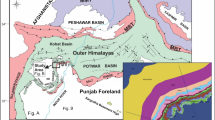Abstract
Himalayan fold belt has full of geological surprises, ‘mélange’ is one of them which create difficulties during tunneling. Such mélange completely went unnoticed during surface mapping and geotechnical investigation preceding the construction of the Udhampur railway tunnel (URT). During the construction, the mélange zone has encountered across the tunnel, which occurs along the Tanhal thrust (equivalent to MBT) that separates the Murree Group and the Shiwalik Group. The mélange was characterized by a chaotic, heterogeneous geological mixture of stronger blocks (scale independence) and weaker sheared fine-grained matrix, often termed as “block-in-matrix rocks” or bimrocks, which enforced mixed face tunneling. The heterogeneity in a tectonic mélange led to stress concentrations in the rock blocks, and there were relatively high deformations within the matrix also. Release of stress from the blocks due to excavation, with unfavorable joint and thrust orientations enforced brittle failure of the blocks (face and crown collapses) while matrix deformation (time dependent) caused convergence of primary support later. Additionally, the clay minerals with high swelling potential within the matrix swelled and created pressure on the primary support. Due to the geomechanical heterogeneity in mélange, homogenizing the rock-mass by the commonly used quantitative systems might have lead to an inappropriate design and construction. The adopted New Austrian Tunneling Method (NATM) proved to be an useful tool for tunneling.
Similar content being viewed by others
References
An Yin (2006) Cenozoic tectonic evolution of the Himalayan orogeny as constrained by along-strike variation of structural geometry, exhumation history and foreland sedimentation. Earth Sci. Rev., v.76, pp.1–131
Barla, G., Bonini, M. and Debernardi, D. (2008) Time dependent deformations in squeezing tunnels, International Association for Computer Methods and Advances in Geomechanics (IACMAG), pp.1-6
Barton, N.R., Lien, R. and Lunde, J. (1993) Engineering classification of rock masses for the design of tunnel support. Rock Mech., v.6(4), pp.189–239
Bieniawski, Z.T. (1989) Engineering rock-mass classification. John Wiley & Sons. New York, USA.
Button, E.A., Schubert, W. and Riedmüller, G. (2002) Shallow tunneling in a tectonic mélange: rock mass characterization and data interpretation. In: Hammah, R., Bawden, W., Curran, J. and Telesnicki, M. (Eds.), Proc. NARMS-TAC 2002, Mining and Tunelling Innovation and Opportunity, July 7-10, Toronto Canada, Univ. Toronto Press, Toronto, 2, pp.1125–1132.
Cai, M, Kaiser, P.K., Uno, H, Tasaka, Y. and Minami, M. (2004) Estimation of rock-mass deformation modulus and strength of jointed rock-masses using the GSI system, Internat. Jour. Rock Mech. and Min. Sci., v.41, pp.3–19
Decelles, P.G., Robinson, D.M., Quade, J. and Ojha, T.P. (2001): Stratigraphy, structure and tectonic evolution of the Himalayan fold-thrust belt in western Nepal. Tectonics, v.20, pp.487–509.
Fuchs, G. (1981) Outline of the Geology of the Himalaya, Mitt, Osterr. Geol. Ges. 74, Wien, pp.101–127
Fuchs, G. and Gupta, V.J. (1971): Palaeozoic Stratigraphy of Kashmir, Kishtwar and Chamba (Panjab Himalayas), Verh. Geol. B.-A.Jahrgang, Wien, pp. 68–97
Gsi (2005) Geological map of Himalaya, the Director General, Geological Survey of India.
Goel, R.K., Jethwa, J.L. and Paithankar, A.G. (1995): Indian experiences with Q and RMR systems, Tunnelling & Underground Space Technology, v.10 (1), pp.97–109
Goel, R.K. and Swarup, A. (2006): A case history of tunneling through difficult ground, Proc. World Tunnel Congress and 32nd ITAAssembly, Seoul, Korea, pp. 22–27.
Heidbach, O., Tingay, M., Barth, A., Reinecker, J., Kurfeß, D. and Müller, B. (2009): World stress map, IIedition, Helmholtz Centre Potsdam -GFZ German Research Centre for Geosciences, Commission for the Geological Map of the World.
Hoek, E., Kaiser, P.K. and Bawden, W.F. (1995) Support of underground excavations in hard rock. Balkema, Rotterdam
Hoek, E. (1999) Support for very weak rock associated with faults and shear zones, Distinguished lecture for the opening of the International Symposium on Rock Support and Reinforcement Practice in Mining, Kalgoorlie, Australia, pp.1–20
Karakus, M. and Fowell, R.J. (2004) An insight into the New Austrian Tunnelling Method (NATM), ROCKMEC2 2004-VIIth Regional Rock Mechanics Symposium, Sivas, Turkey.
Kontogianni, V. and Stiros, S. (2003) Tunnel monitoring during the excavation phase: 3-D kinematic analysis based on geodetic data. Proc. 11th FIG Symp. on Deformation Measurements, Santorini, Greece.
Medley, E.W. and Goodman, R.E. (1994) Estimating the block volumetric proportion of melanges and similar block-inmatrixrocks (bimrocks). In: Proc. 1st North American Rock Mechanics Conference (NARMS), Austin, Texas, Balkema, Rotterdam, pp.851–858.
Medley, E.W. (1994) Using stereological methods to estimate the volumetric proportions of blocks in mélanges and similar block-in-matrix-rocks (bimrocks), In: 7th International IAEG Congress, Lisbon, Portugal; Balkema, Rotterdam, pp.1031–1040.
Medley, E.W. (1998) Confronting geological complexity: Working with melangebimrocks. In: 8th International IAEG Congress, Vancouver, Canada; Balkema, Rotterdam, pp.227–233.
Kumar, A., Prakash, B. and Velapure, Y. (2008) NATM experience in PirPanjal rail tunnel, World Tunnel Congress-Underground Facilities for Better Environment and Safety-India, pp.1585–1596.
Müller, L. and Fecker, E. (1978) Grundgedanken und Grundsätze der Neuen Österreichischen Tunnelbauweise–“Basic ideas and principles of the New Austrian Tunnelling Method” In: Trans Tech Publications, pp.247–262.
Printzl, F., Bharadwaj, V., Gurenc, A.H. and Garg, A. (2008) Construction of Pir Panjal Railway Tunnel-NATM experience in the Himalayas, World Tunnel Congress-Underground Facilities for Better Environment and Safety-India, pp.1459-1468
Raymond, L.A. and Terranova, T. (1984): Prologue: The mélange problem–a review. Geol. Soc. Amer. Spec., v.198, pp.1–5.
Rites (2008) Report on geotechnical investigation for tunnel no. 1 of Udhampur-Katra Rail Link Section in J&K state; Unpubld. Report.
Russo, G. (2007) Improving the reliability of GSI estimation: the integrated GSI-RMi system. Proc. I.S.R.M. Workshop “Underground Works under Special Conditions”, Madrid, pp.123–130.
Sharma, M.L. and Shankar, D. (2001): Estimation of seismic hazard parameters in the Himalayas and its vicinity from mixed data-files, ISET Jour. Earthquake Tech., v.38, pp.93–102.
Author information
Authors and Affiliations
Corresponding author
Rights and permissions
About this article
Cite this article
Dhang, P.C. Tunneling in lesser Himalaya, Jammu and Kashmir, India with special emphasis on tectonic mélange. J Geol Soc India 88, 593–602 (2016). https://doi.org/10.1007/s12594-016-0525-3
Received:
Accepted:
Published:
Issue Date:
DOI: https://doi.org/10.1007/s12594-016-0525-3




